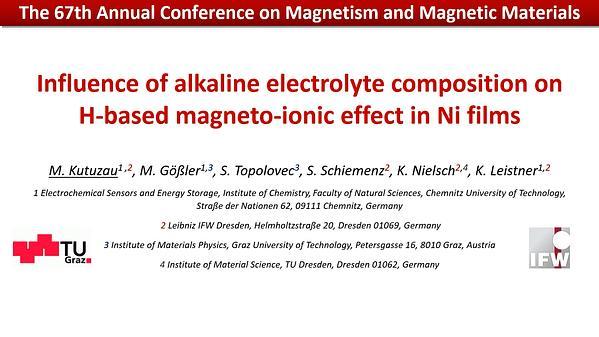Would you like to see your presentation here, made available to a global audience of researchers?
Add your own presentation or have us affordably record your next conference.
Complex magnetic materials hosting topologically non-trivial particle-like objects such as skyrmions are intensely researched and could fundamentally change the way we
store and process data. One important class of materials are helimagnetic materials with Dzyaloshinskii-Moriya interaction. Recently, it was demonstrated that nanodisks consisting of two
layers with opposite chirality can host a single stable Bloch point of two different types 1. The Bloch point represents an interesting topological excitation in a helimagnetic system, which
expands the set of well-known magnetic states such as domain walls, vortices, and skyrmions.
In this work 2, we use micromagnetic simulations 3, 4 to show that FeGe nanostrips consisting of two layers with opposite chirality can host multiple coexisting Bloch points. We
demonstrate that the two different Bloch-point types (Fig. 1) can be geometrically arranged in any arbitrary order, and these magnetization configurations are meta-stable (within certain
constraints on the strip width and length). We can determine an optimal spacing between Bloch points within a line of Bloch points (corresponding to a distance over which a Bloch point
extends). This allows us to predict strip geometries suitable for an arbitrary number of Bloch points, which we verify for an example 80-Bloch-point configuration (Fig. 2).
References
1 M. Beg et al., Scientific Reports, Vol. 9, p. 7959 (2019).
2 M. Lang et al. arXiv:2203.13689 (2022).
3 M. Beg, M. Lang and H. Fangohr, IEEE Transactions on Magnetics, Vol. 58, p. 7300205 (2022)
4 M. Beg, R. A. Pepper and H. Fangohr, AIP Advances, Vol. 7, p. 56025 (2017)

Fig. 1 (a) The Bloch-point configuration originates from vortices with identical circularity, but opposite polarisation, which are stabilised through the DMI of the material, which fixes the
core orientation relative to circularity through the left- or right-handed chirality. (b, c) Simulation results for the two different Bloch-point types.

Fig. 2 ASCII encoding of the string "Blochpoint" using 80 Bloch points. The two cross sections show an xy plane in the top layer and an xz plane at the Bloch-point position. The strip length is chosen according to the predicted value for a nanostrip with width w = 100 nm.
